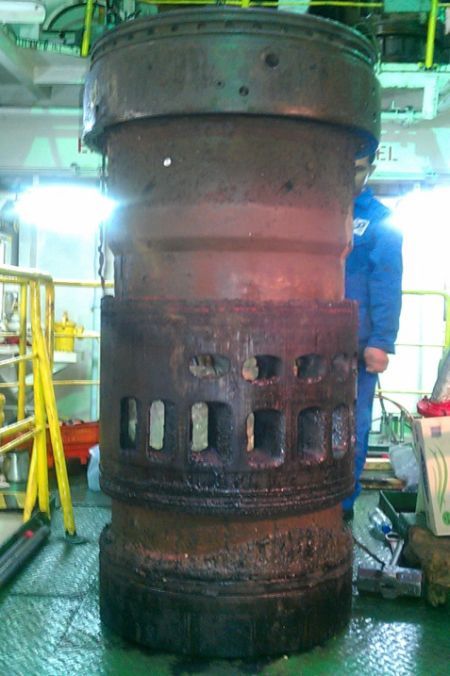
PROJECT FACTS: Bulk Carrier Liner Removal
Engine Type: Sulzer 7RLB 56
Engine Output: 6,135 kW (8,341 hp)
SIEZED LINER REMOVAL
MOBILIZES GOLTENS IN-SITU
AND DIESEL TEAMS
IN-SITU LINER REMOVAL AND LINER LANDING
MACHINING FOR SULZER 7RLB-56
Following an urgent request by the owner of a bulk carrier,
Goltens deployed a diesel team to attend a vessel in port in
Mina Saqr. The owner requested Goltens perform the removal
of a liner from vessel’s Sulzer 7RLB-56 main engine, a very
routine job for Goltens. Upon investigation however, what
started out to a routine task, quickly developed into a much
more complex task.
After several attempts to remove the liner with normal tooling,
it became apparent that the liner, which had not been
removed for many years, was badly seized and that an
alternative method would have to be used. Goltens Diesel and
In-Situ engineers discussed the challenge and although it was
agreed that the most efficient way to remove the liner would
be to use a gas torch to split the liner, after carrying out a risk
assessment, it was apparent that this operation was inherently
dangerous due to the confined work area.
Goltens proposed an alternative method for splitting the liner
by angle grinder and slitting disc. Although this was slightly
more time consuming, the process proved very effective and
posed a significantly safer execution.
Once the liner was split, the team damned an area within the
liner and packed it with dry ice to shrink the liner and enable
removal. The dry ice was applied for 20 hours and a pressure
of 1,300 bar applied to force the liner out of the engine block.
Once the liner was clear, inspection of the liner landing
surfaces revealed significant corrosion on the O-ring seal
area. In addition to the area of corrosion, there was also an
area on the liner landing surface area where a large crack had
occurred. The damaged and corroded areas were discussed
with the crew and immediately the request was made to
mobilize In-situ technicians with necessary tooling to carry out
a repair.
REPAIRS CONSISTED OF:
• Removal of Liner
• Metal stitching of liner landing face to repair crack
• Rough machining bore for installation ring
• Fabrication of ring for bore (7.5mm thickness)
• Shrink fit installation of ring using dry ice
• Final machining bore
• Final machining liner landing
• Installation of new liner and engine rebuild
RESULTS:
Upon completion of the In-Situ machining, Goltens’ Diesel
teams were re-mobilized and the re-assembly of the engine
was carried out. This full operation from start to finish was
carried out working around the clock with careful coordination
between Goltens’ Technical departments and
client. As a result, the engine was repaired and operational
with ship back in service inside the time estimated.
We use cookies to improve your experience. By continuing to use our site, you accept our Cookies, Privacy Policy,Terms and Conditions. Close X